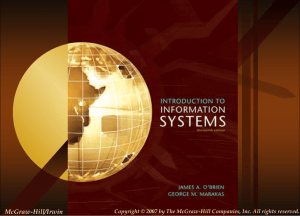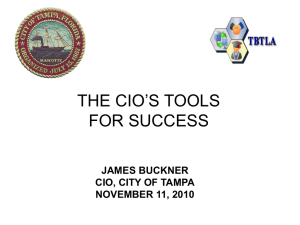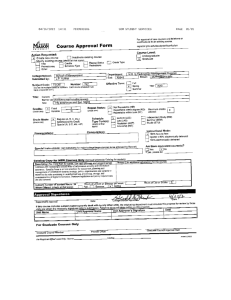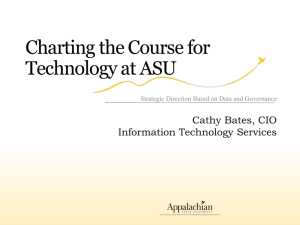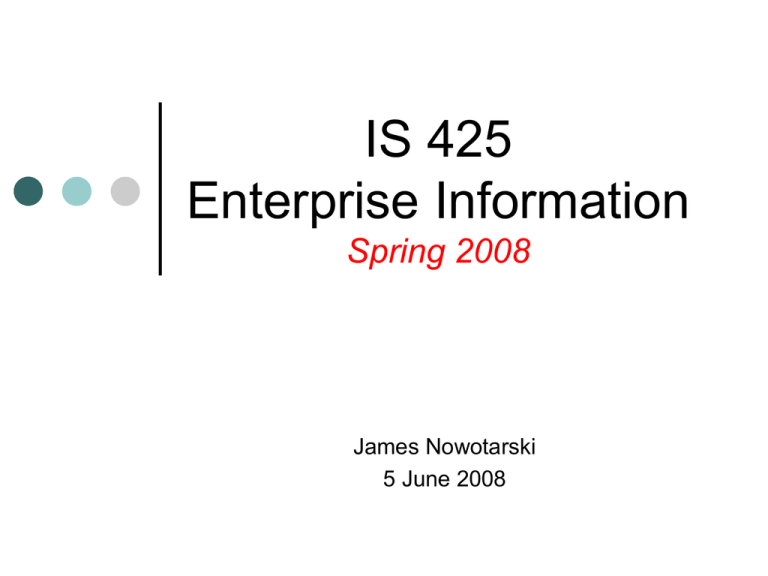
IS 425
Enterprise Information
Spring 2008
James Nowotarski
5 June 2008
Today’s Agenda
Topic
5/29 recap
IT governance
*** Break
Duration
30 minutes
45 minutes
15 minutes
Current event report
10 minutes
IT emerging trends and issues
75 minutes
Wrap-up
10 minutes
2
Creating a project “work plan”
requirements
Cust
1
Negotiate
reqts
negotiated
requirements
2
Decompose
work
breakdown
structure
3
Estimate
size
deliverable
size
4
Estimate
resources
workmonths
5
Develop
schedule
3
Iterate as necessary
schedule
Deliverable-oriented WBS
Copyright © 2006 The
McGraw-Hill Companies. All
rights reserved.
Activity-oriented WBS
Copyright © 2006 The
McGraw-Hill Companies. All
rights reserved.
Planning process
requirements
Users
1
Negotiate
reqts
negotiated
requirements
2
Decompose
work
breakdown
structure
3
Estimate
size
deliverable
size
productivity rate
4
Estimate
resources
workmonths
5
Develop
schedule
Iterate as necessary
schedule
6
Units of software size
Lines of code (LOC)
Function points (FP)
Components
7
Computing Function Points
Simple
Measurement parameter Count
Avg
Com
-plex
Number of user inputs
5
X
3
4
6
=
15
Number of user outputs
X
4
5
7
=
Number of user
inquiries
8
10
X
3
4
6
=
32
40
Number of files
8
X
7
10
15
=
80
Number of external
interfaces
2
X
5
7
10
=
10
177
Count (Unadjusted
Function Points) UFP
Reconciling FP and LOC
LANGUAGE
1032/AF
1st Generation default
2nd Generation default
3rd Generation default
4th Generation default
5th Generation default
Assembly (Basic)
BASIC
C
C++
COBOL
JAVA
Visual Basic 5
AVERAGE SOURCE
STATEMENTS PER
FUNCTION POINT
16
320
107
80
20
5
320
107
128
53
107
53
29
http://www.theadvisors.com/langcomparison.htm
Components
Simple
Medium
Hard
# Database
tables
# Reports
Etc.
10
Planning process
requirements
Users
1
Negotiate
reqts
negotiated
requirements
2
Decompose
work
breakdown
structure
3
Estimate
size
deliverable
size
productivity rate
4
Estimate
resources
workmonths
5
Develop
schedule
Iterate as necessary
schedule
11
Bottom-up estimating
Estimate = #units x time per unit
For example, a report design task:
10 reports
3 hours per report
Estimate = 30 person-hours (aka
“workhours”
Most projects are estimated in this
way, once details are known about
units
12
Other estimating techniques
Expert judgment
Analogy
Algorithmic
General model:
E = A + B x (ev)c
where
E is effort in person months
A, B, and C are empirically derived
constants
ev is the estimation variable (either in
LOC or FP)
13
Software size estimation
formulae
LOC-Oriented Estimation Models
E = 5.2 X (KLOC)0.91
Walston-Felix Model
E = 5.5 + 0.73 X (KLOC)1.16
Bailey-Basili Model
E = 3.2 X (KLOC)1.05
Boehm simple model
E = 5.288 X (KLOC)1.047
Dot Model for KLOC > 9
FP-Oriented Estimation Models
E = -13.39 + 0.0545 FP
Albrecht and Gaffney
Model
E = 60.62 X 7.728 X 10-8
FP3
Kemerer model
E = 585.7 + 15.12 FP
Matson, Barnett,
Mellichamp model
14
Top-down vs. Bottom-up
Planning & Managing
Communication
project initiation
requirements
Modeling
analysis
design
Top-down
“approximating”:
- Expert judgment
- Analogy
- Algorithmic
Construction
code
test
Deployment
delivery
support
Bottom-up “estimating”
15
Estimating accuracy
improves over time
http://sunset.usc.edu/research/
COCOMOII/index.html
16
Planning process
requirements
Users
1
Negotiate
reqts
negotiated
requirements
2
Decompose
work
breakdown
structure
3
Estimate
size
deliverable
size
productivity rate
4
Estimate
resources
workmonths
5
Develop
schedule
Iterate as necessary
schedule
17
GANTT Schedule
• View Project in Context of
time.
• Critical for monitoring a
schedule.
• Granularity 1 –2 weeks.
18
One of the primary jobs of a
project manager is to manage
these tradeoffs
19
IT organizations that require
PMI certification for PM’s
20
Source: Standish Group, 2007
IT Organization
The business situation will drive the degree to
which IT is weighted toward business users vs. IT
concerns
Business user concerns
• Responsiveness
• Customization
• Innovation
IT concerns
• Efficiency
• Standards
• Control
Business situation
Organizational design challenge: Centralized
hierarchies support control and efficiency . . .
Cons
Pros
Unresponsive
Economies
of scale
No business unit (BU)
ownership
Doesn’t meet every
BU’s needs
Shared
standards
Critical mass
of skills
Compliance
control
Purely centralized
. . . while the decentralized model supports flat
organizations with responsibility on the “edges”
Pros
Speed
Cons
Redundant
functions/costs
Promotes risk,
innovation
Proliferation of data,
platforms
Responsive to
BU’s needs
Variable quality, control
Lack of synergy and
integration
Purely decentralized
The “hybrid” or “federal” model is the best
structure for balancing business user and IT
concerns
Hybrid/Federal IT model
Shared vision &
leadership
Unresponsive
No business unit (BU)
ownership
Doesn’t meet every
BU’s needs
Economies
of scale
Speed
Redundant
functions/costs
Shared
standards
Promotes risk,
innovation
Proliferation of assets,
delivery vehicles, rollouts
Critical mass
of skills
Responsive to
BU’s needs
Variable quality, control
Control
Purely centralized IT
Consistent
quality
Synergy &
Integration
Mutual trust &
commitment
Lack of synergy and
integration
Purely decentralized IT
Source: MIT
Hybrid/Federal IT
CEO
Architecture
CIO
Operations
VP Finance
VP Marketing
Function 1
Function 1
Sys dev’t
Finance
Sys dev’t
Marketing
VP Product A
Function 1
Sys dev’t
Product A
VP Product B
Function 1
Sys dev’t
Product B
Sys. dev’t
IT Outsourcing
Information technology (IT) outsourcing is a
multiyear contract/relationship involving the
purchase of one or more IT services
Drivers
•
Cost reduction.
•
Cost predictability.
•
Improved performance levels. For example, speed of delivery,
customer satisfaction, quality, etc. These are especially relevant for
seasonal businesses where volume fluctuates widely.
•
Desire to refocus on corporate core competencies.
•
Desire to have in-house IT resources focus on strategic systems
and/or technology.
© James W. Nowotarski
27
IT Outsourcing
Information technology (IT) outsourcing is a
multiyear contract/relationship involving the
purchase of one or more IT services
Drivers (continued)
•
Lack of in-house IT resources. This includes personnel resources
and computing resources such as hardware capacity.
•
Desire to become and stay technologically current.
•
Financial factors. Outsourcing typically involves the outsourcing firm
making up-front payment to the customer firm for a transfer of people
and/or computing assets. This improves the balance sheet and shortterm cash flow.
•
Desire to overcome internal inertia and resistance to change.
•
Increased recognition of the strategic benefits of alliances.
© James W. Nowotarski
28
IT Outsourcing
Multisourcing Example: Nissan
Service Provider
Deal Scope
Satyam (India)
Application support
• Maintenance
• Enhancement
IBM Global Services IT infrastructure
Internal
Business analysis
Project management
Note: Prior to April 2006, all of the above had been outsourced to IBM
© James W. Nowotarski
29
IT Offshoring
Offshore - A location/development center
in a country remote from the country in
which the service or process is consumed
or touches the end user or customer
Source: Gartner Group
© James W. Nowotarski
30
IT Offshoring
Cost, quality, and speed are the main
reasons for going offshore
• Reduce cost
– 40-50% savings, according to Merrill Lynch CTO
• Higher quality/capability
– A disproportionately high percentage of CMMI Level 5 systems
development organizations are in India (CMMI Level 5 is the top
level of performance on an industry benchmark)
• Speed
– A “follow the sun” approach allows for 24x7 work on a project
© James W. Nowotarski
31
IT Offshoring
India is the leading location for offshore
sourcing
Reasons
• Highly capable workforce
– 2-3M college graduates per year (will double by 2010)
– #2 in world in computer science grads (china #1, U.S. #3)
• Focus on process and product quality
– “Quality has become an obsession with the software developers in India”
– Casimir Welch, American Society for Quality Fellows
• Low labor and infrastructure costs
• Government commitment and support
• English (and other) language skills
© James W. Nowotarski
32
IT Offshoring
India’s advantage is beginning to erode
Reasons
• Competition for talent is driving salaries up by as much
as 30% per year
• China, Russia, Mexico, Vietnam and Philippines are
training armies of programmers to compete with India
– BearingPoint chose Shanghai for its new software
development center . . . pays $500/month for
engineers in Shanghai, $700 in India, $4000 in U.S.
• Increasing competition closer to the customer, e.g.,
– “Nearshore”, e.g., Mexico and Canada for U.S. customers
– “Onshore”, e.g., Rural Arkansas
© James W. Nowotarski
33
Global delivery
Planning;
high level
tasks
Common processes
technology and tools
Execution
Hofstede Cultural Dimensions Framework
• Individualism versus collectivism
– Identifies whether a culture holds individuals or the group
responsible for each member’s welfare.
• Power distance
– Describes degree to which a culture accepts status and power
differences among its members.
• Uncertainty avoidance
– Identifies a culture’s willingness to accept uncertainty and
ambiguity about the future.
• Masculinity-femininity
– Describes the degree to which the culture emphasizes
competitive and achievement-oriented behavior or displays
concerns for relationships.
Copyright © 2006 The McGraw-Hill Companies. All rights reserved.
Sample Country Clusters on Hofstede’s Dimensions
of Individualism-Collectivism and Power Distance
Copyright © 2006 The McGraw-Hill Companies. All rights reserved.
Today’s Agenda
Topic
5/29 recap
IT governance
*** Break
Duration
30 minutes
45 minutes
15 minutes
Current event report
10 minutes
IT emerging trends and issues
75 minutes
Wrap-up
10 minutes
37
IT Governance: Definition
• The operating model for how the organization
makes and enacts decisions about the use of IT
• What is meant by “operating model”?
–
–
–
–
Organizational units involved
Division of roles, responsibilities, and accountabilities
Processes, standards, policies
Measurements
• What types of decisions are we talking about?
– What IT goals and priorities will enable the organization and
maximize benefits
– How to obtain and deploy IT resources
– How to appropriately mitigate and control risk
38
IT Governance: Example
• Proposal: Replace proprietary and/or locally
implemented reporting systems with a single,
global management reporting system
• Hard to justify on purely economic grounds
• Local units will be resistant, but their cooperation
is essential to the success of the initiative
• Who decides? Who is accountable for the
implementation of the decision? How will the
results of the decision be measured and
monitored?
39
Senior management of the
enterprise devoting more
attention to IT governance
Reasons
Enterprises are more dependent than ever
on IT
Enterprises need to maximize the business
value from their [often] large investment in
IT
An increasing percentage of IT spending is
controlled by business units
IT viewed as “strategic partner” vs. “order
taker”
40
Senior management of the
enterprise devoting more attention
to IT governance (cont.)
Reasons (cont.)
• Historically poor performance of IT
• Tendency of IT to focus on itself
• Increased variety of service delivery models
(cloud computing, multisourcing, etc.) creates
complexity
• Regulatory focus in post-Enron era, e.g.,
Sarbanes Oxley
41
IT Organization Design vs.
Governance
Central headquarters
Steering
Comm.
IT
IT
Marketing
IT
Finance
IT
Manufacturing
External
parties
Decision-making processes
• Goals
• Priorities
• Risk mitigation
• Value from IT
• Who does what
42
IT Governance vs. IT
Management
CoBIT’s 34
standard IT
processes
Source:
isaca.org/
cobit
Today’s Agenda
Topic
5/29 recap
IT governance
*** Break
Duration
30 minutes
45 minutes
15 minutes
Current event report
10 minutes
IT emerging trends and issues
75 minutes
Wrap-up
10 minutes
45
Market trends
Globalization
Volatility
Innovation
[Green] energy
Information explosion
Wall Street effect
Moore’s Law
Aging population
Faster, better, cheaper
46
IT Emerging Trends
and Issues
Executives’ Club of Chicago
survey of technology executives
regarding plans for 2008
The number one required change in IT??
CIO’s most important focus area??
Focus area most gaining in importance??
Top 2 technologies??
48
What will be the biggest
change for CIOs in the next
five years (Gartner)?
Fundamentally, the biggest changes
will revolve around a shift in focus
from technology to business results.
This will involve more strategic
thinking not just from the CIO, but the
entire IT services staff.
Source: Gartner ITXpo, April 2008
49
No. 1 Concern of CIOs for
2008 (SIM)?
In a 2007 SIM survey of 130 senior IT
execs, 51% cited, “attract, develop,
and retain IT professionals” as a top
concern, more than any other factor.
Source: InformationWeek, January 7, 2008
50
CIO answers to “What are your top
3 initiatives” (InformationWeek)
Create an analytical infrastructure and
enterprise information architecture
Accenture
Arise
Cambridge Integrated Services
Foley & Lardner LLP
Freescale Semiconductor
Iron Mountain
Jackson Family Enterprises
51
CIO answers to “What are your top
3 initiatives” (InformationWeek)
Support growth/globalization
Accenture
Arise
CME
GM
Rockwell Automation
Migrate from disparate, legacy systems to
an enterprise system
Accenture
Freescale Semiconductor
Rockwell Automation
52
CIO answers to “What are your top
3 initiatives” (InformationWeek)
Infrastructure improvements (e.g., reliability)
CUNA
Global Crossing
Data center consolidation
Foley & Lardner LLP
Foundry Networks
53
CIO answers to “What are your top
3 initiatives” (InformationWeek)
Balanced portfolio of people, processes,
technology
CUNA
Mueller Water Products
Enterprise 2.0
Accenture
Motorola
54
CIO answers to “What are your top
3 initiatives” (InformationWeek)
Implement local and remote failover
environments
Green equipment/vendors
Cadence Design Systems
ITIL implementation
Foundry Networks
Red Hat
Voice and video over IP
Foundry Networks
55
CIO answers to “What are your top
3 initiatives” (InformationWeek)
Enterprise content management
Geographic information systems
Jackson Family Enterprises
Jackson Family Enterprises
Service oriented architecture (SOA)
1-800-Flowers.com
56
CIO answers to “What are your top
3 initiatives” (InformationWeek)
Improve customer experience at web site
1-800-Flowers.com
Decomposing and refactoring legacy
systems
Iron Mountain
57
CIO answers to “What are your top
3 initiatives” (InformationWeek)
Software engineering productivity gains
Project management office
Cadence
Arise
Issue tracking and resolution
Red Hat
58
CIO answers to “What are your top
3 initiatives” (InformationWeek)
Increase business value of IT
Motorola
59
Enterprise 2.0 is reaching the
mainstream
“Enterprise 2.0 is reaching the mainstream,
and companies that do not aggressively
adopt enterprise 2.0 will experience serious
competitive threats within three years.”
Source: Rollyson, The Global Human
Capital Journal
60
Enterprise 2.0 is reaching the
mainstream
The Machine is Us/ing Us (Michael Wesch) (Mar. 2007) (4:33)
* http://youtube.com/v/NLlGopyXT_g
Enterprise 2.0: What is it (Andrew McAfee) (Apr. 2008) (3:30)
* http://www.youtube.com/watch?v=6xKSJfQh89k
Enterprise 2.0: Hype or Happening? (CIOs) (Feb. 2008) (1:32)
* http://www.youtube.com/watch?v=i2WOCIMGx5Q
61
Enterprise 2.0 is reaching the
mainstream
What is it
Unified communications
• Messaging
• Presence
Information sharing
•
•
•
•
•
•
Blogs
Social bookmarking
Social networking
Tagging
Virtual worlds
Wikis
62
Example: Facebook
www.facebook.com
63
Example: Serena Software
Facebook Fridays
Private Facebook group as a front
end linked to a low-cost content
management system behind the
firewall
Public Facebook groups to connect
with marketplace
Customers
Recruits
64
Facebook platform: “f8”
Launched May 24, 2007
24,000 applications built on the platform
An application is a module Facebook's users can
add to their pages and then invite their Facebook
friends to join
About 140 applications added per day
The most successful apps generate ad revenue
Example: Scrabulous - $18K/month
Most users have added at least one application
65
Facebook platform: “f8”
What’s in it for users?
For application developers?
For Facebook?
66
Example: IBM’s SmallBlue autogenerates social networks
67
Enterprise 2.0 is reaching the
mainstream
Benefits
Cost reduction
• Tools can be cheap to acquire/operate
Improved collaboration (internal or external)
Agility
• “Only 11% of organizations believe they are
highly adaptable” - IBM
Innovation
• Via cross-silo collaboration
• Via collaboration with customers
Productivity???
68
Enterprise 2.0 is reaching the
mainstream
Challenges
Control
Information overload
• Called “problem of the year” for 2008
Demonstrating ROI
Legal (“land mine”)
Privacy
Security
Requires a culture of trust
69
Enterprise 2.0 discussion
Enterprise 2.0 vs. Web 2.0
Business applications of Enterprise 2.0
Compare/Contrast Enterprise 2.0 with
enterprise applications
70
Anatomy of an Enterprise
System
Source: Adam & Sammon
Networked Economy 2.0 (Rollyson
reading): Highlights:
72
Job Market
Job Market Notes
Average U.S. IT employment is 12% higher
than a year ago, hitting an all-time high of
3.8 million IT jobs (Bureau of Labor
Statistics, March 2008)
Areas of demand
Architects
IT auditors
Business intelligence analysts
Applications developers
Networking
Data administration
75
Holistic view
Process
People
Technology
76
Today’s Agenda
Topic
5/29 recap
IT governance
*** Break
Duration
30 minutes
45 minutes
15 minutes
Current event report
10 minutes
IT emerging trends and issues
75 minutes
Wrap-up
10 minutes
77
For June 12
Final (submit via COLWeb)
78
Extra slides
79


